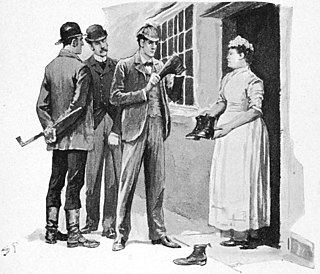
Detective fiction is a subgenre of crime fiction and mystery fiction in which an investigator or a detective—whether professional, amateur or retired—investigates a crime, often murder. The detective genre began around the same time as speculative fiction and other genre fiction in the mid-nineteenth century and has remained extremely popular, particularly in novels. Some of the most famous heroes of detective fiction include C. Auguste Dupin, Sherlock Holmes, and Hercule Poirot. Juvenile stories featuring The Hardy Boys, Nancy Drew, and The Boxcar Children have also remained in print for several decades.
Ellery Queen is a pseudonym created in 1929 by American crime fiction writers Frederic Dannay and Manfred Bennington Lee and the name of their main fictional character, a mystery writer in New York City who helps his police inspector father solve baffling murders. Dannay and Lee wrote most of the more than thirty novels and several short story collections in which Ellery Queen appeared as a character, and their books were among the most popular of American mysteries published between 1929 and 1971. In addition to the fiction featuring their eponymous brilliant amateur detective, the two men acted as editors: as Ellery Queen they edited more than thirty anthologies of crime fiction and true crime, and Dannay founded and for many decades edited Ellery Queen's Mystery Magazine, which has been published continuously from 1941 to the present. From 1961, Dannay and Lee also commissioned other authors to write crime thrillers using the Ellery Queen nom de plume, but not featuring Ellery Queen as a character; several juvenile novels were credited to Ellery Queen, Jr. Finally, the prolific duo wrote four mysteries under the pseudonym Barnaby Ross.

The Detection Club was formed in 1930 by a group of British mystery writers, including Agatha Christie, Dorothy L. Sayers, Ronald Knox, Freeman Wills Crofts, Arthur Morrison, Hugh Walpole, John Rhode, Jessie Rickard, Baroness Emma Orczy, R. Austin Freeman, G. D. H. Cole, Margaret Cole, E. C. Bentley, Henry Wade, Constance Lindsay Taylor and H. C. Bailey. Anthony Berkeley was instrumental in setting up the club, and the first president was G. K. Chesterton. There was a fanciful initiation ritual with an oath written by Sayers, and the club held regular dinner meetings in London.
Julian Gustave Symons was a British crime writer and poet. He also wrote social and military history, biography and studies of literature. He was born in Clapham, London, and died in Walmer, Kent.
Cecil John Charles Street, who was known to his colleagues, family and friends as John Street, began his military career as an artillery officer in the British Army. During the course of World War I, he became a propagandist for MI7, in which role he held the rank of Major. After the armistice, he alternated between Dublin and London during the Irish War of Independence as Information Officer for Dublin Castle, working closely with Lionel Curtis. He later earned his living as a prolific writer of detective novels.
The Golden Age of Detective Fiction was an era of classic murder mystery novels of similar patterns and styles, predominantly in the 1920s and 1930s.

The Narrowing Circle is a 1956 British crime film directed by Charles Saunders and starring Paul Carpenter, Hazel Court and Russell Napier. It is based on the 1954 novel of the same title by Julian Symons. The film's sets were designed by the art director Wilfred Arnold.
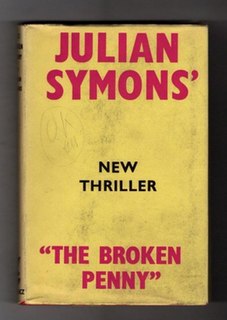
The Broken Penny is a 1953 thriller novel by the British writer Julian Symons set during the early Cold War.

The Man Who Killed Himself is a 1967 comedy crime novel by the British writer Julian Symons.

The Kentish Manor Murders is a 1988 mystery detective novel by the British writer Julian Symons. A pastiche of the traditional Sherlock Holmes stories by Arthur Conan Doyle, it is a sequel to the 1975 novel A Three-Pipe Problem.
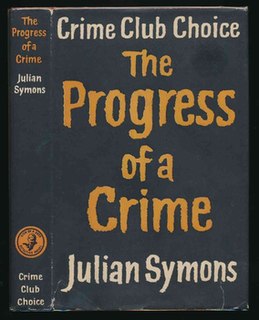
The Progress of a Crime is a 1960 mystery crime novel by the British writer Julian Symons. It was awarded the 1961 Edgar Award.
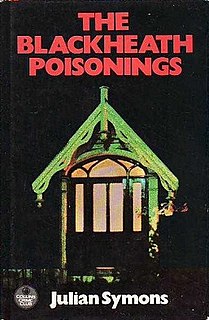
The Blackheath Poisonings is a 1978 historical mystery novel by the British writer Julian Symons. It is a murder mystery set in the late Victorian era.

The Colour of Murder is a 1957 crime novel by the British writer Julian Symons. It was awarded the Gold Dagger of the Crime Writers' Association for that year. It was republished by British Library Publishing in 2018 along with another Symons novel The Belting Inheritance.

The End of Solomon Grundy is a 1964 crime novel by the British writer Julian Symons. The title refers to a line in the nursery rhyme Solomon Grundy.

Sweet Adelaide is a 1980 historical crime novel by the British writer Julian Symons. It is based on the real-life 1886 Pimlico Mystery concerning the possible murder Thomas Bartlett by his wife Adelaide. Symons had already enjoyed success with another Victorian-set mystery The Blackheath Poisonings.
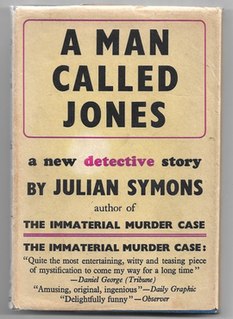
A Man Called Jones is a 1947 mystery detective novel by British writer Julian Symons. It is the second novel in his trilogy featuring the Scotland Yard detective Chief Inspector Bland. Symons was critical of the "Great Detective" that features in so many novels during the Golden Age of Detective Fiction and demonstrates this in the climatic scene where Bland assembles all the suspects to explain his theory, only to first send them to sleep and then be confronted by the late arrival of a previously unknown character on which the whole puzzle hinges.

The 31st of February is a 1950 mystery crime novel by British writer Julian Symons. It was his fourth published novel following a trilogy featuring Chief Inspector Bland. It further continued the author's toying with the Great Detective type of the classic model during the Golden Age of Detective Fiction. The investigating officer in a potential murder case, Inspector Cresse, is far from flattering portrayed.

The Paper Chase is a 1956 mystery crime novel by the British writer Julian Symons. It was published in America the following year by Harper & Brothers under the alternative title of Bogue's Fortune. It was reviewed by fellow writers Milward Kennedy in The Guardian and Philip John Stead in the Times Literary Supplement.

The Plot Against Roger Rider is a 1973 mystery thriller novel by the British writer Julian Symons. The novel takes place both in England and Francoist Spain. It was published in the United States by Harper.
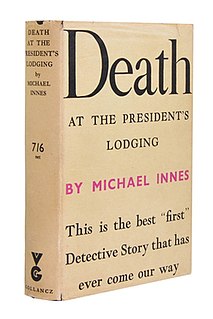
Death at the President's Lodging is a 1936 detective novel by the British writer Michael Innes. It was the first in a series of novels featuring John Appleby, a Detective Inspector in the Metropolitan Police. It is a traditional closed circle of suspects mystery, taking place in a fictitious Oxbridge college located in Bletchley about halfway between Cambridge and Oxford on the Varsity Line. It was released in the United States by Dodd, Mead under the alternative title Seven Suspects.
















